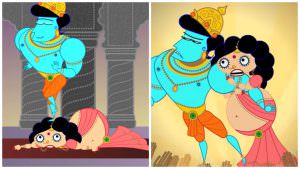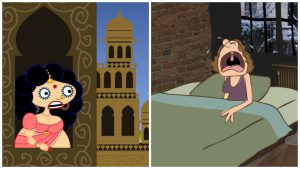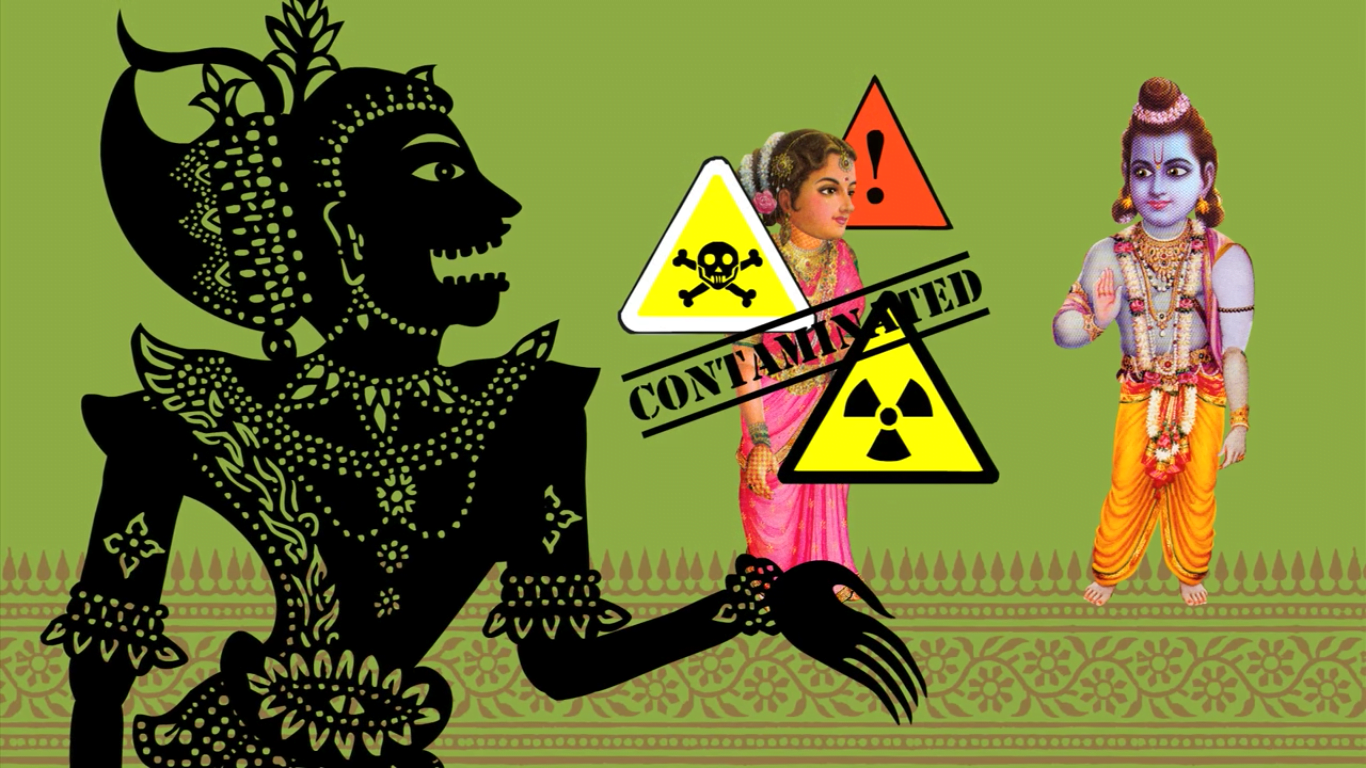Nina Paley created the unapologetically quirky, irreverent, and unconventionally animated film Sita Sings the Blues after her own divorce from her husband. She saw in the tale of Ramayana, which the film juxtaposes with the story of Nina’s own divorce, “the greatest break-up story ever told.” The film tells the tragic story of Sita, who was first kidnapped by Ravana and then cast away (twice) by her husband Rama on suspicions of infidelity.
https://www.youtube.com/watch?v=1QkYOqI3jSM
However, this tale of woe is narrated anything but tragically. Sita’s story is peppered with the wildly anachronistic jazz songs of 1920s singer Annette Hanshaw. An impossibly curvy Sita thus sings of her woes to the upbeat tempo of Hanshaw’s numbers, like when she sultrily croons “My Man Don’t Love Me No More” when Rama abandons her. Paley’s Sita reacts to her tragedy with trills instead of tears, abandoning a woe-is-me approach in favour of waist-shaking foot-tapping jazz numbers, which are, let’s face it, way more fun. (Also, this film gave me the rather valuable information that calling one’s lover “daddy” is not a modern-day sexy black woman thing, because Annette Hanshaw beat Beyoncé to it by decades. Paley’s Sita parrots Hanshaw in a plaintive song titled “Daddy, Won’t You Please Come Home?” whilst waiting for Rama to rescue her from Lanka.)

A still from Sita Sings The Blues
Now we all know that the Ramayana is no feminist masterpiece. Sita follows her husband Rama to the forest, and then remains devoted to him despite the horrible way he treats her, volunteering for an agni pariksha (trial-by-fire) to prove her purity when he questions her faithfulness to him. (She does kind of kick ass as a single mom in the forest though, when she raises the two sons of the husband who banished her when she was pregnant.) Rama however, in popular cultural opinion, is held up as the absolute icon of dharma and virtuousness. His flaws as a husband are excused as the sacrifices required for kingship, where of course, treating women kindly isn’t a priority. And Sita’s submissive nature has long been held up as a model of wifeliness in India. Nationalist leaders have often urged Indian women to adopt her virtues of pativrata (devotion to husband) in order to attain that “Perfect Wife” status that Sita endorsed so well in her multiple sacrifices for her husband.
However, Paley, like millions of other women in India, found in Sita a resonance of her own marital frustration. In a culture where divorce is hardly ever an option, and women are often given little to no power in the fate of their marriages, Sita occupies the status of an everywoman. Like the many women who have retold the Ramayana, Paley deals with her grief at her hurtful husband by channelling a fierce sympathy for Sita’s treatment at the hands of Rama.

Paley does this by subtly criticizing Rama, stripping him of his much-touted “divine virtue”. Well, actually not so subtly. Rather hilariously, Rama’s estranged sons, Lava and Kusha sing a song in praise of their absentee father, as taught to them by the poet-sage Valmiki. This song, starting out nice and well with “Rama’s great, Rama’s good, Rama does what Rama should,” quickly descends into a nursery-rhyme style singalong where the twins dutifully intone:
“Sing his love, sing his praise,
Rama set his wife ablaze.
Got her home, kicked her out,
To allay his people’s doubt.”
Paley’s light-hearted jabs at Rama are an act of resistance towards male-dominated narratives of the Ramayana that paint Rama as the ultimate man of dharma. By making an antagonist out of the usually infallible Rama, Paley launches a critique of his deeply patriarchal and unfair behaviour towards Sita.
But Paley’s critique of the Ramayana goes beyond simply championing Sita’s story over Rama’s. In the gentle, irreverent, humorous way she tells this story, she’s also criticizing the monolithic, heavy-handed and hegemonic version of the Ramayana that have been espoused by the Hindu right in the country. The Ramayana is a myth, passed on through oral traditions, from grandmother to grandchild in countless households in India. Yet, when scholar A. K. Ramanujam wrote an essay on the 300 Ramayanas that he believed existed in the Indian subcontinent, it was banned by the Hindutva right for being sacrilegious. The very nature of mythologies is its plurality. They arise from hundreds of different sources and interweave with local beliefs and traditions in delightfully interesting manifestations. The enforcement of a unitary notion of the Ramayana strips away at these multitudes.
Sita Sings the Blues loosely follows the dominant Valmiki version of the epic. However, the story is narrated and commented upon by three faceless narrators, who recount the story of the epic from memory – completely unscripted. These narrators sound much like my friends and me – urban, educated Indians having a chat over cups of chai and Marie biscuits. And much like my friends and me, they are often iffy about the details of the epic. The film starts with them arguing over when the Ramayana was supposed to have happened. One says the 14th century, while the other scoffs at her and says that that’s when the Mughals were probably in India, so it must have been in the BC. Eventually, they settle on “a long, long, time ago.”
They jokingly allude to this sacrosanct nature of the Ramayana that they might accidentally be defiling with their ignorance. One of the narrators says, “I’m messing up the names… God, they’re going to be after me!” And on another occasion, the narrators all wonder why Sita couldn’t just go back with Hanuman, instead of waiting for Rama to come save her, thereby avoiding this huge, messy war. They end with, “Don’t challenge these stories, yaar!” (And if Hindutva hell is a thing, these narrators definitely earned their place in it when they wondered if Rama and Sita were part of the Mile-High Club, considering Sita became pregnant so quickly after her airborne voyage back home from Lanka.)
The story itself, when not being narrated, is told with these 2-D animations, wherein the animation styles keep varying – sometimes psychedelic, sometimes old-school Indian art, sometimes cartoon-like. In these animations, the characters of the Ramayana speak to each other in painfully ornate tones, keeping in character of ‘a long, long, time ago’, but occasionally break character to deliver golden lines like, “Your ass is grass.” For example, when Dasaratha banishes Rama, he delivers a long, sonorous speech on how he must keep his word to his wife Kaikeyi. After he’s done, Kaikeyi dryly adds, “Don’t let the door hit your ass on the way out!”
Paley’s irreverence with the handling of this epic gently mocks the strict unilateral understanding of the Ramayana championed by right-wing groups. Far from being blasphemous, what Paley does is reclaim the narrative for herself. She dislodges it from its status as religious doctrine and brings it back to the realm of myth, which is malleable to imagination. She takes this reclamation one step further, reclaiming it not just for herself, but every single viewer. The film’s opening credits read, “Your Name Here presents…” and then goes on to display its producers, “Funded by You”. The audience thus become stakeholders in the narrative. Paley actively encourages the audience to make the story our own, reminding us that the Ramayana can be ours as much as it was Valmiki’s or Tulsidas’.
About the author(s)
Asmita is a Freelance Communications Consultant, and specialises in leading digital advocacy campaigns for social and gender justice issues. When not using social media for work, she uses social media for fun (and a healthy dash of existential despair).





” ….Paley, like millions of other women vin India…” ??? Nina Paley is a white American woman! This particular work of her is probably about 10 years old — at least old enough for people to be able to do this much research before publishing such a late review of it, on feminisminindia.com in Nov. 2016
Hi. I realize that the phrasing of that sentence might led to it being misunderstood. I meant that Paley, who I know is a white American women, found solace in the tale of Sita LIKE millions of Indian women have also done.
firstly do you ever read Ramayana before writing this? if you ever did, it glorified both Lord Rama and Sita matha. it show how tough decisions and sacrifices are made and how it bring sadness to both of them.Lord Rama , throughout all his life sacrificed everything to uphold Dharma, he didnt sat on the throne for 14 years to respect his step mother(who is also a woman) and the word of his father.in the forest an asura woman tried to seduce him by changing herself to a beautiful woman but he rejected her and chase her away.this asura woman later brainwash her brother to kidnap Sita matha as an act of revenge.after she was kidnapped Lord Rama obstacles,dangers to save her back…even after that both of them are separated and all their life (as humans)they never manage to be together for long time never did they look for other alternatives to fulfill that.its one of the most beautifully written epic literature the world have seen, tell me honestly,from your heart as a human do you think Paley s so called animation glorified both or condemned one of them? and that one character is one of the most revered character in Hindu related literature history.when Paley made this so called art i was upset, its about a god i worship daily been made fun of in the name of art and entertainment.in Hinduism( in case views,critical thinking, opinions and creativity are always welcomed but never it encourages condemning not only for the issues relating within hinduism but also to the belief,culture and philosophy of others.we dont have to protest and furious about this Paley creation but do we have to support it and encourage it?